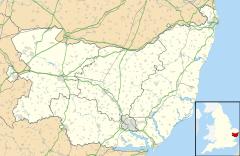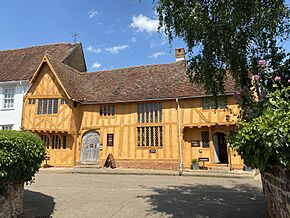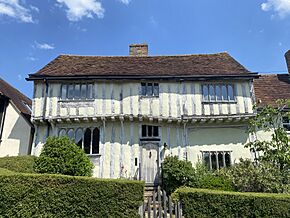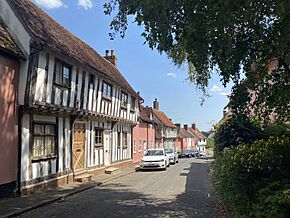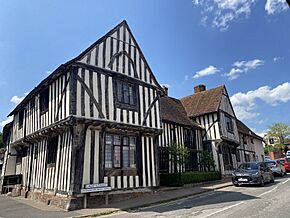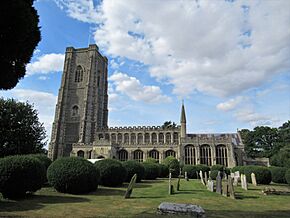Lavenham facts for kids
Quick facts for kids Lavenham |
|
|---|---|
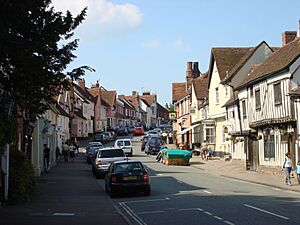 High Street, Lavenham |
|
| Population | 1,722 (2011) |
| OS grid reference | TL915491 |
| • London | 76.3 miles |
| Civil parish |
|
| District |
|
| Shire county | |
| Region | |
| Country | England |
| Sovereign state | United Kingdom |
| Post town | SUDBURY |
| Postcode district | CO10 |
| Dialling code | 01787 |
| Police | Suffolk |
| Fire | Suffolk |
| Ambulance | East of England |
| EU Parliament | East of England |
| UK Parliament |
|
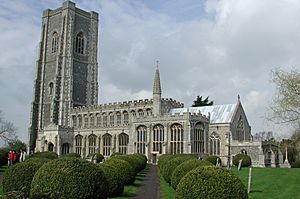
Lavenham is a beautiful village in Suffolk, England. It is famous for its old buildings, like the Guildhall and Little Hall. You can also see its amazing 15th-century church and many half-timbered medieval houses. In the Middle Ages, Lavenham was one of the richest places in England. In 2011, about 1,722 people lived there.
Contents
A Look Back: Lavenham's History
Before the Normans came to England, a person named Ulwin owned the land where Lavenham now stands. In 1086, a powerful family, the de Veres, took over. They even had a vineyard there! This family owned Lavenham until 1604.
The Wool Trade and Wealth
Lavenham became very rich in the 1400s and 1500s because of the wool trade. The village was known for its special blue cloth. By the late 1400s, Lavenham was one of the wealthiest towns in the British Isles. It paid more taxes than much bigger cities like York and Lincoln. Important merchant families, like the Spring family, grew very successful.
The amazing wealth of Lavenham can still be seen today. The huge St Peter and St Paul's Church was built with money from the wool trade. It was finished in 1525. This church is much bigger than you would expect for a village. Its tower is 138 feet (42 meters) tall, making it one of the tallest village church towers in Britain. Other buildings also show how rich the town was. The Lavenham Wool Hall was completed in 1464.
The Guildhall was built in 1529. It stands in the middle of the village, looking over the market square. In 1487, King Henry VII visited Lavenham. He even fined some families for showing off too much wealth!
Decline and Preservation
However, Lavenham's good times did not last. In the 1500s, Dutch refugees settled in Colchester. They made cloth that was cheaper and lighter than Lavenham's. This new cloth was also more fashionable. Cheaper goods from Europe also hurt Lavenham's trade. By 1600, Lavenham was no longer a major trading town.
This sudden loss of wealth is why so many medieval and Tudor buildings in Lavenham are still standing. People didn't have enough money to tear them down and build new ones in the latest styles. This means we can still see Lavenham's amazing history today.
The Little Hall
The Little Hall is a very old house on the main square. It was first built in the 1390s as a family home and workshop. It was made bigger and more modern in the 1550s. By the 1700s, six different families lived there. It was fixed up in the 1920s and 1930s by two brothers, Robert and Thomas Gayer-Anderson. Today, it is a museum. It holds the Gayer-Anderson collection of art and old items.
Important Events in Lavenham
In 1525, during the time of King Henry VIII, Lavenham was part of a big protest. People were angry about a new tax called the 'Amicable Grant'. About 10,000 men from Lavenham and nearby villages protested. The King's dukes, with help from local families, stopped the uprising.
Queen Elizabeth I visited Lavenham in 1578. During the English Civil War in the 1640s, Lavenham supported Parliament. Many local landowners were strong supporters of Parliament. The town even sent soldiers to help with the Siege of Colchester in 1648.
A grammar school opened in Lavenham in 1647. Sadly, the village was hit by the plague in 1666 and 1699. Small pox also caused many deaths in 1712 and 1713.
In the late 1700s, the poet Jane Taylor lived in Lavenham. It is thought that she wrote the famous poem The Star (which became Twinkle Twinkle Little Star) while living on Shilling Street.
Lavenham in World War II
During World War II, Lavenham had an airfield. It was called Air Force Station Lavenham. The USAAF Station 137 was used by the US Army Air Force 487th Bombardment Group from 1944 to 1945. The airfield is now farmland, but you can still see some parts of it, like the control tower.
In 1969, John Lennon and Yoko Ono filmed part of their movie Apotheosis in Lavenham's Market Place. They used a hot-air balloon!
Lavenham's Location and Landscape
Lavenham is about five miles northeast of the town of Sudbury. It is built on a hill next to the River Brett. The hill has two small valleys that divide it into three parts. The church is on the southernmost part. The marketplace is in the middle. The northernmost part has the remains of an old windmill.
One of the valleys has a small stream that was covered up 500 years ago. Water Street was built over it. This is a very old example of town plumbing! The other valley also has a stream and was once the path of an old railway line.
Getting Around Lavenham
Lavenham is on the A1141, which is the main road between Hadleigh and Bury St Edmunds. Large trucks can sometimes cause problems on the village's narrow streets.
Lavenham used to have a railway station. It opened in 1865. The railway was important for carrying goods during World War II. The station closed for passengers in 1961 and for goods in 1965. Today, the old railway line is a public walking path and a nature reserve.
Schools in Lavenham
Children in Lavenham go to Lavenham Community Primary School. This school is for pupils aged 5 to 11. After primary school, students usually go to Thomas Gainsborough School.
Lavenham's Population Over Time
| Historical population of Lavenham | |||||||||||||||||||||||||||||||||||||||||||||||||||||||||||||||||||||
|---|---|---|---|---|---|---|---|---|---|---|---|---|---|---|---|---|---|---|---|---|---|---|---|---|---|---|---|---|---|---|---|---|---|---|---|---|---|---|---|---|---|---|---|---|---|---|---|---|---|---|---|---|---|---|---|---|---|---|---|---|---|---|---|---|---|---|---|---|---|
|
|
|
|
||||||||||||||||||||||||||||||||||||||||||||||||||||||||||||||||||
| Source: Census: Regional District 1801–1971 | |||||||||||||||||||||||||||||||||||||||||||||||||||||||||||||||||||||
Famous People from Lavenham
Many interesting people have lived in or been connected to Lavenham:
- Thomas Spring of Lavenham (c. 1474 – 1523), a rich cloth merchant.
- William Gurnall (1616–1679), a church leader who wrote a famous book.
- Jane Taylor (1783–1824), the poet who wrote Twinkle, Twinkle, Little Star.
- Robert Grenville Gayer-Anderson (1881-1945), a soldier and collector who lived in the Little Hall.
- Sir Stephen Spender (1909–1995), a well-known English poet and writer.
- Eamon Boland (born 1947), an English actor.
Gallery
See also
 In Spanish: Lavenham para niños
In Spanish: Lavenham para niños


